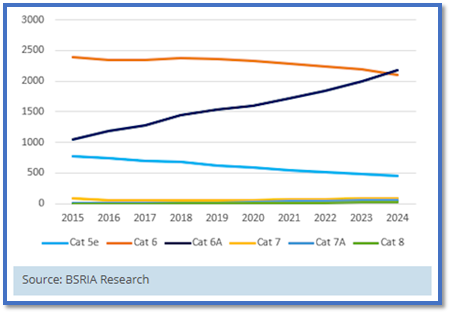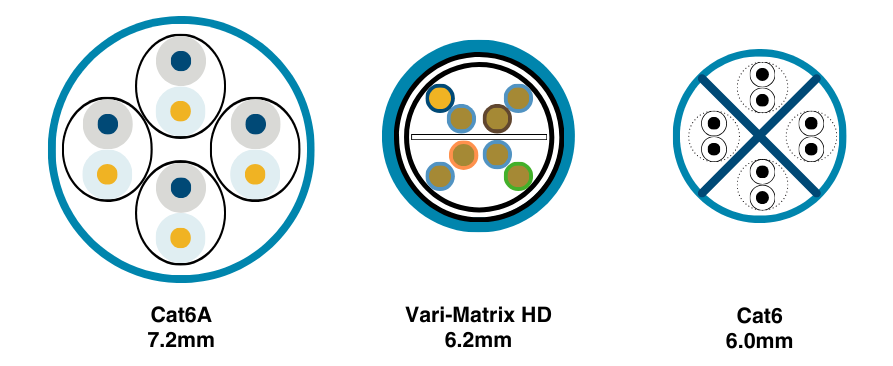— Published on 14 Feb 2024

Building Services Research and Information Association (BSRIA) predicts that category 6A cable usage will surpass category 6 by 2024, driven by increased demand in data centers and LAN applications (2020).

Figure 1. Reference from Source: https://www.bsria.com/uk/news/article/structured_cabling_market_
is_slowing_down_despite_growing_demand_from_data_centres/.
Selecting the right cable for a 3 to 5-year support horizon is pivotal, influenced by industry standards and application requirements.
Industry standards, established by organizations like TIA (Telecommunications Industry Association) and ISO (International Organization for Standardization), provide guidelines and criteria for consistency, interoperability, and quality across sectors. These standards promote efficiency and sustainable solutions aligned with today's focus on environmentally friendly practices. TIA and ISO standards are widely adopted in network cabling deployment.
The latest standards recognize category 6 and 6A for balanced twisted-pair cabling and components. Category 6A is recommended for a broader range of applications, including wireless access points. Key standards include:
In today's context, two primary applications utilize copper cabling solutions: wireless access points (WiFi) and closed-circuit television (CCTV). Both applications are Power over Ethernet (PoE) supported.
WiFi enables seamless internet connectivity for devices without the need for cable connections. With high data rate* demands, especially in office environments, WiFi is often utilized by employees. However, slow connectivity issues may arise due to:
*Wi-Fi 6 uplink reaches up to 9.6G, whereas Wi-Fi 7 uplink achieves up to 30G. Refer to the Wi-Fi deployment page for more information.
CCTV, on the other hand, demands lower data rates but relies heavily on POE power*. With the advent of advanced devices and the Internet of Things (IoT), the need for higher data rates and POE will persist.
*CCTV power consumption ranges from 5W to 51W. Refer to the CCTV deployment page for more information.
Cat6A is recommended for its advantages over Cat6. Here are some key benefits of Cat6A compared to Cat6:
| Category | Maximum Bandwidth | Highest Media Applications | Data Rate | Connector Type |
|---|---|---|---|---|
| 6 | 250MHz | 1000BASE-T | Up to 1G | RJ45 |
| 6A | 500MHz | 10GBASE-T | Up to 10G | RJ45 |
| Type | Standards | Maximum Current | Power at Device | Maximum Data Rate |
|---|---|---|---|---|
| PoE | IEEE 802.3af (802.3 at Type 1) | 350 mA | 13 W | 1000BASE-T |
| PoE+ | IEEE 802.3at Type 2 | 600 mA | 25.5 W | 1000BASE-T |
| PoE++ (4PPoE) |
IEEE 802.3bt Type 3 IEEE 802.3bt Type 4 |
600 mA 960 mA |
51 W 71 W |
10G0BASE-T |

The decision between Cat6A and Cat6 hinges on application requirements aligned with industry standards. Cat6A, with its advantages, suits diverse environments and futureproofing needs. Conversely, Cat6 may suffice for past lower bandwidth requirements. The decision should be thoughtful, ensuring a tailored and efficient solution for specific application needs.
Large Paragraph Text Used As A Subheading
Pellentesque non magna eget ex lobortis finibus. Lorem ipsum dolor sit amet, consectetur adipiscing elit. Etiam nec arcu non eros hendrerit viverra a vitae libero. Etiam et ultricies nulla. Donec euismod lectus magna, eu dignissim mauris hendrerit vulputate.
| Time | Place | Details |
|---|---|---|
| 10:00 am - 10:55 am | Expo Hall | Meet and greet in the lobby outside the Expo Hall before the General Assembly. |
| 11:00 am - 11:55 am | Rm 314 | Expert Track: TOP 10 WAYS TO MAKE A DIFFERENCE IN THE INDUSTRY | John Dough, CFO Marketizingly |
| 11:00 am - 11:55 am | Rm 159 | Social Track: MODERN NETWORKING | Hosted by: SponsorName |
Pellentesque non magna eget ex lobortis finibus. Lorem ipsum dolor sit amet, consectetur adipiscing elit. Etiam nec arcu non eros hendrerit viverra a vitae libero. Etiam et ultricies nulla. Donec euismod lectus magna, eu dignissim mauris hendrerit vulputate.